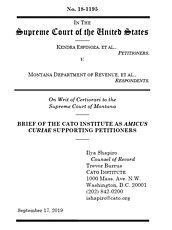Learn more about Cato’s Amicus Briefs Program.
In the late 19th century, dozens of states enacted amendments banning government aid to churches, religious schools, and other “sectarian” organizations. These “Blaine Amendments,” named after Senator James G. Blaine of Maine, who failed to secure the passage of a similar amendment to the U.S. Constitution, remain in force in many parts of the country. At the time these amendments were passed, it was widely understood that public schools followed a curriculum sympathetic to Protestantism to the exclusion of other religious traditions. “Sectarian” was a euphemism for “Catholic” and the Blaine amendments were widely recognized as an effort to bar funding to Catholic schools. While their anti-Catholic motivations are now a matter of history, Blaine amendments, such as Article X, Section 6 of the Montana Constitution, are still in effect and often serve as a pretext for discrimination against religious groups.
Kendra Espinoza is a single mother who works two jobs to afford her daughters’ private-school tuition. When her youngest daughter struggled in public school and her older daughter was bullied, Kendra decided to enroll them both in Stillwater Christian School in Kalispell, Montana, where they have since flourished. At Stillwater, Kendra feels that her faith is supported by the school’s Christian character. Kendra benefited from a Montana program that provides tax-credit incentivizes for donations to scholarship funds that have lessened the burden of her daughters’ tuition. When the Montana Department of Revenue issued a rule excluding Stillwater Christian from the tax-credit program, her children’s educational future was put in jeopardy.
While the Revenue Department defended its distinction between secular and parochial schools, the Montana Supreme Court ruled more broadly, holding that the tax-credit program as a whole violated the state constitution by authorizing aid to religion.
But under the First Amendment, states may not impair the free exercise of religion or pass any laws regarding the establishment of religion. This case thus raises the question: can a state strike down a neutral, generally available educational program simply because some of the program’s beneficiaries have directed their (not state) dollars to religious organizations? If the Department of Revenue prevails, states will have greater power to reduce school choice and single out religious organizations for unfair treatment.
Fortunately, the U.S. Supreme Court agreed to review the case, after Cato supported Ms. Espinoza’s petition for review. Cato has now filed a Supreme Court brief on the merits. We argue that the Free Exercise Clause does not allow Montana to exclude religious organizations from public benefits solely because of their religious association. Not only does the Establishment Clause allow these kinds of incentives, but there is no room in Supreme Court precedent to exclude religious schools from programs structured around private choice (as opposed to, say, direct taxpayer funding of devotional education). The Montana court’s decision does not change the discriminatory nature of the state’s Blaine Amendment.

This work is licensed under a Creative Commons Attribution-NonCommercial-ShareAlike 4.0 International License.




